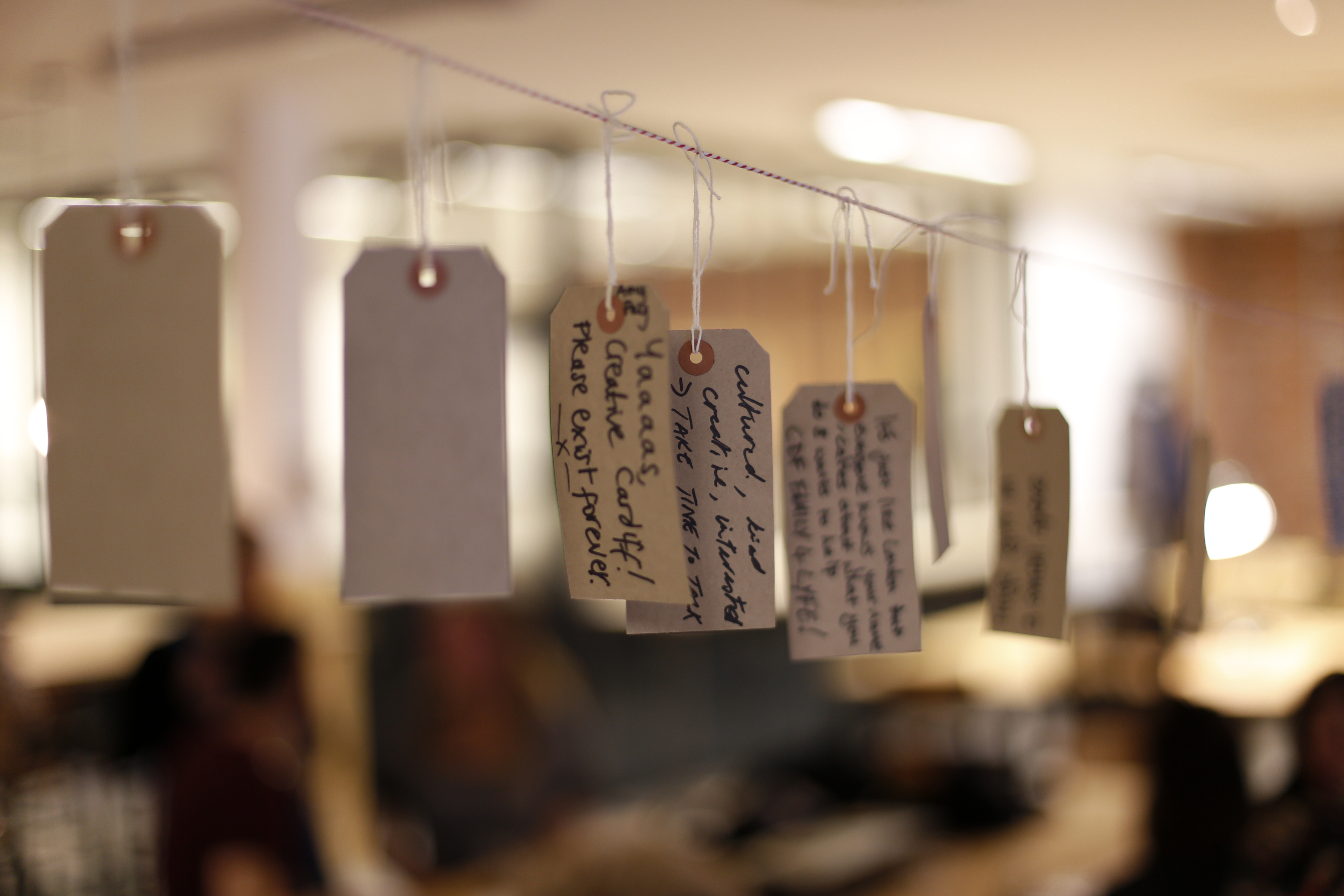Independent brand and communications consultant Mathew Talfan explores issues around creating an identity for our capital city.
The question of a city’s identity is always a tricky one; it can mean many different things to many people - a patchwork of qualities, amenities, perceptions and experiences. A city’s residents might have one idea, corporations and government often another. And there’s usually some truth in all of them, suggesting that any notion of a common, agreed ‘identity’ has to flex and adapt to reach different audiences. All in all, it can be a complicated process.
Two events held by Creative Cardiff over the past month have addressed this question in different ways. At the recent Hub Crawl - a Friday evening trek between three of the city’s newest co-working spaces, we were asked how we might describe our city to other people when we meet them.

At a second event held at Cardiff and Vale College, a cross section of artists, practitioners and professionals with an interest in the creative and cultural industries spent half a day exploring the city’s identity and the stories that help define it.
Both events addressed important issues around Cardiff and the way it sees itself. It’s clear that the creative sector shares many common beliefs around what makes Cardiff’s heart tick; multiple references to the human scale and qualities of the city, its welcoming nature and the benefits of strong, effective networks, coupled with recognition that the city already has an exciting blend of established companies, a dynamic and growing underground scene, and a fair mix of everything in between.
But combining these stories into a coherent narrative is a big challenge. It’s a search for a central idea or approach that not only frames all our stories but is both unique and own-able, building on a key defining characteristic of our city that helps explain our place in the world. It requires an identity that everyone with a stake in the city can understand, share and contribute to, not just the creative sector. In a recent post about the role geography has played in shaping our city I touched on some of these issues; this same source may also provide a starting point for a new articulation of our identity.
The story - and shape - of modern day Cardiff really began during the industrial revolution. Our role as a port city - once the busiest in the world - put us at the heart of global trade. The valleys were a rich source of coal and iron ore - and needed a means to help transport their cargo to market. People came to help build the canals, railways, ports and communities and to extract the minerals from the land. During the many years of trade which ensued, South Wales welcomed a global community of people, many of whom made it their home, and in the process helped create a place with deep, enduring connections across the world.
The story that emerged during this period of economic and demographic growth is the same as that which frames our current role as the modern capital of a nation – as a bridge between Wales and the world. It’s certainly a more compelling idea than simply being the location for a national administration! It enlarges the scope of the nation. The cultural and creative industries are conscious of this and would be well placed to build on it to shape an identity that both the city and the nation can share in. And in many ways, the people, communities and organisations of Cardiff are already inhabiting the role.
In 1801 the population of Cardiff was approximately 5,000; a century later it was nearer 150,000. Today, as it approaches 350,000 with further significant growth ahead, Cardiff remains a fast growing city. It also suggests two things - one, that the level of growth we are now experiencing should not be alien to us nor frighten us, and second, that pretty much all of us in Cardiff, deep down, are ‘new arrivals’ - descended from people who moved here from somewhere else - a real life melting pot of heritages (whether Welsh, English, Irish, European, African, Asian, Middle Eastern, Caribbean or any other). For generations, Cardiff has been that bridge between Wales and the world.
Today, that same bridge between Wales and the world can be found in many activities across the city - particularly in education, sport, culture and business.
- Cardiff is a city of learning - with over 60,000 students coming to our universities and colleges. During their studies this emerging generation of talented individuals build new relationships with the city - many of which will help define Cardiff’s future and our place in the world.
- Major sporting events - and not just rugby anymore - colour the city and create stories and images that spread quickly around the globe. Iconic venues coupled with high profile major events also bring us together as people - and allow us to share the stage with other nations and build bonds and friendships that cross national borders.
- Our cultural offer is both strong and varied. The city is home to an array of acclaimed national and long established companies and organisations, as well as a less well known plethora of smaller organisations, artists, groups, galleries, events and festivals. These are dimensions to the city that we should cherish, nurture and celebrate. After all, what is the role of culture if not to help us reflect, understand and to question the world we live in, from the global to the local?
- The creative industries play a big part in the city’s modern identity. Much of this has been driven by the role of broadcasters based here - BBC Cymru Wales, S4C and ITV Wales, but beyond the broadcasters, an array of independent producers, post-productions houses, designers, developers, architects, journalists and makers are all contributing to a thriving creative economy - an economy intrinsically connected to global markets, trends and talent pools.
- Cardiff is also a growing business city: over the next 10 years, it is projected that a further 40,000 jobs will be created in the city centre. We have distinctive strengths in several sectors, not least in the creative industries, bio-science, and financial and professional services. Many of these industries have strong international dimensions, putting our businesses and people at the heart of global trade and industry.
So, our links to the world are strengthening, but to be a true bridge between Wales and the world, Cardiff also needs to work on its relationship with the rest of Wales. Capital cities and the nations they serve often show tensions in their relationships - in this respect Wales’ capital is no different to Edinburgh, Dublin or London. But there are signs of shifts taking place that point to a healthier, more productive relationship between capital and country in the future.
During the most recent Creative Cardiff event, writer Dan Tyte, in a talk about his own experiences of growing up in Cardiff and how it has changed over the past few decades, suggested that "Cardiff has never felt more Welsh". He makes a good point. Cardiff certainly feels far more at ease with being Wales’ representative city - twenty years of devolution, significant urban development, and a Welsh language that is more evident and audible than it has ever been in the city. Coupled with sporting, cultural and business success a new confidence and a fresh perspective is emerging.
The development of the Cardiff Capital Region City Deal - and the South Wales Metro project - is an example of this new outlook in action. The recently signed accord between ten local authorities should open a door to a new era of collaboration between local governments across South East Wales and can encourage us all to seek new relationships with each other as well as with the world. The work of turning the deal into firm plans - and then executing them - will provide stern tests. Partners will have to learn to pool certain responsibilities, in order to deliver the bigger opportunities. Political rivals (sometimes of the same hue!) will need to set aside their differences in order to deliver on the bigger vision. We know that transport is set to play a central role in this new collaboration, but culture and creativity can also add real meaning and vibrancy, a distinctive local flavour, and an enhanced profile while delivering important economic contributions to long-lasting transformational change.
At the same time, investments in technology and transportation are themselves changing the model for new business development. Connectivity is key - and essentially performs a similar function - a bridge between places, people or ideas. The capital region is a step towards pooling and sharing opportunity in South East Wales and this process should provide important learning that can be extended across the whole of Wales. Location is not always everything; connectivity is.
But identity is not just about our relationship with ‘others’, it’s also about how we feel about ourselves. It’s not just about attracting people or companies to ‘do stuff’ in Cardiff - it has to say something about our own desire to make valid contributions - whether on global or local stages. A sustainable economy depends on providing the right environment for our home-grown creativity to thrive too. After all, most big businesses tend to start as small ones!
The recent Hub Crawl visited three new co-working spaces in Cardiff - Rabble Studio, The Sustainable Studio and Tramshed Tech.
We love this #timelapse from our #hubcrawlc stop @TSSWales. Cheers to @DrJ_Gregory @CUCreative for capturing! #coworking pic.twitter.com/dYiZsO29FS
— CreativeCardiff (@CreativeCardiff) March 7, 2017
These kinds of spaces are cropping up across Wales - places such as Indycube (various locations), Welsh ICE (Caerphilly), Hŵyl Hub (Merthyr), Tech Hub (Swansea). They are often driven by passionate, determined individuals or small groups. They provide the types of flexible spaces where fledgling companies and freelance workers work side by side - the sort of environment new businesses need in those critical early days. It’s more organic, collaborative, sometimes even slightly chaotic - but it seems a much closer fit with the way many modern ventures transition from idea to execution - particularly in the creative sector.
So, yes, we live in an era of change. Cardiff continues to evolve. Just like it always has. Some of that change we can influence and control, some may be our response to the way the world is changing around us. In the midst of this change, its important that we maintain a clarity of thought and vision, and careful use of the levers that we do control - planning, infrastructure, education and training. But we also need to build an identity that belongs to us, that inspires us - and others - and says something about who or what we are. Through that, we can share our stories, and shed light on the many things we do so well. We can be that vital connection between Wales and the world; meaningfully connected to both, passionate, confident and outward looking, open to new ideas, co-operation and collaboration.
In that simple idea of the city as a bridge, we can reveal the essence of Cardiff’s identity - as a place that connects a nation to the world - through its people, communities, and organisations, its history and its aspirations for the future. It was Wales and the wider world that partly helped shape our city, and create the conditions that earned us our capital status. With that status comes responsibility and opportunity in equal measure. We should embrace both, for our benefit and that of Wales and the world.

